What It Feels Like to Be Caught Inside a California Wildfire
Updated: Nov. 28, 2022
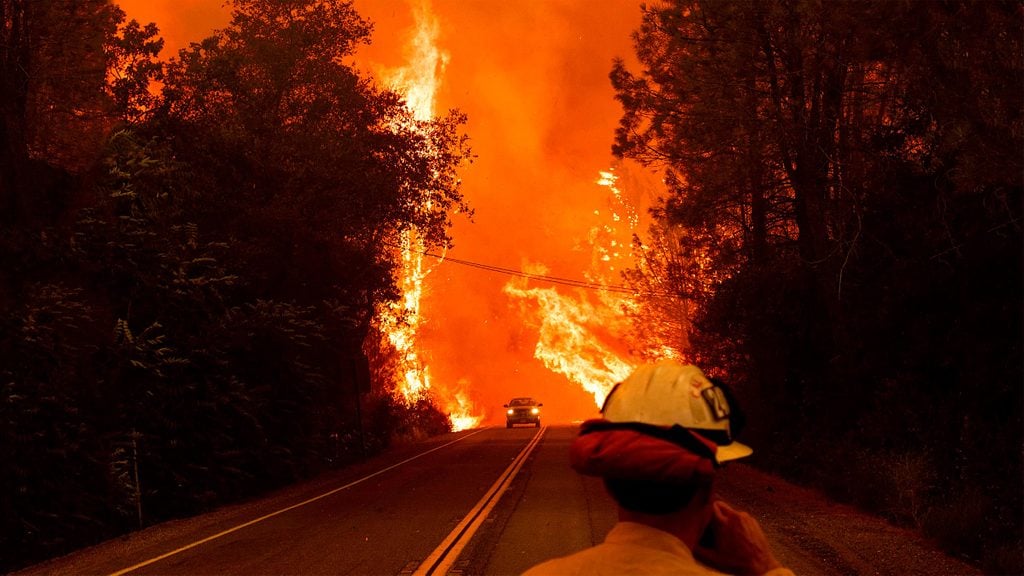
Half inferno, half cyclone, the Carr Fire burned as hot as 2,700 degrees and packed winds that turned trucks into wayward missiles. Would anyone caught inside it survive?
Death blew east on a savage wind, driving flames over foothills and across a river, spitting glowing embers and scrubbing the earth bare. It was coming for Don Andrews.
The firestorm shook the ground and roared as loud as a passing train. The windows on Andrews’s bulldozer shattered, flinging glass into his face. The blue-green shards were everywhere: on the floor, inside his helmet, in his skin and eyes. He was alone and blinded.
I’m not going to survive this, he thought.
Andrews, 60, wasn’t supposed to be this close to the edge. He’d been hired that day, July 26, 2018, by the California Department of Forestry and Fire Protection (Cal Fire) to work with two other bulldozer drivers to carve a thick ring of dirt around a subdivision of homes near the city of Redding. It was a fairly routine assignment—the containment lines were three dozer blades wide and designed to halt the advance of the wildfire, which was still miles away.
What Andrews didn’t know was that the Carr Fire—to that point a rather ordinary California blaze—had spawned something monstrous: a fire tornado the likes of which the state had never seen.
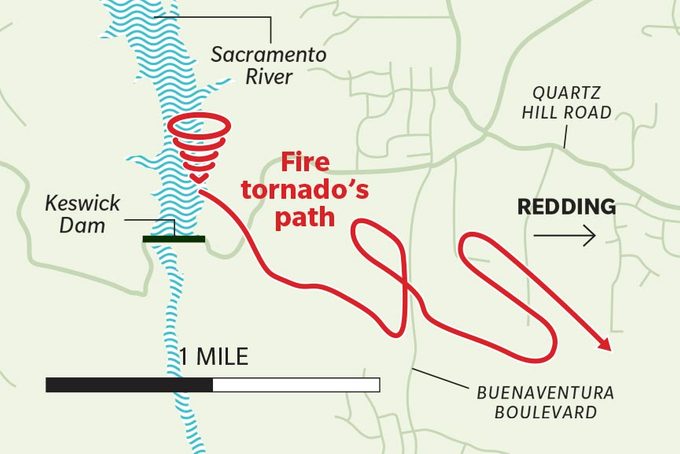
A freak of meteorology, it would annihilate everything in its path, uprooting trees and crumpling electrical towers. It was a vortex of air wrapped around a column of rising heat, flames licking its unseen walls.
Andrews hunkered down. He gripped the dozer’s protective foil curtains closed with his left hand to keep the wind from batting them open. With his right hand, he pulled his shirt over his nose and mouth. The heat seared his throat.
Temperatures within the tornado soared to 2,700 degrees Fahrenheit. A nearby Cal Fire truck exploded.
Andrews dialed 911. His singed hands trembled. A dispatcher answered, on the verge of tears. Dozens of others had phoned in already, describing the unfolding hell. Now here was a call from ground zero.
“I don’t know how long I can last,” Andrews told her. “I need to get out of here.”
“If you can, get out safely, OK?”
“I can’t. It’s all on fire around me. Don’t risk anybody’s life for mine.”
“Nobody is going to believe this.”
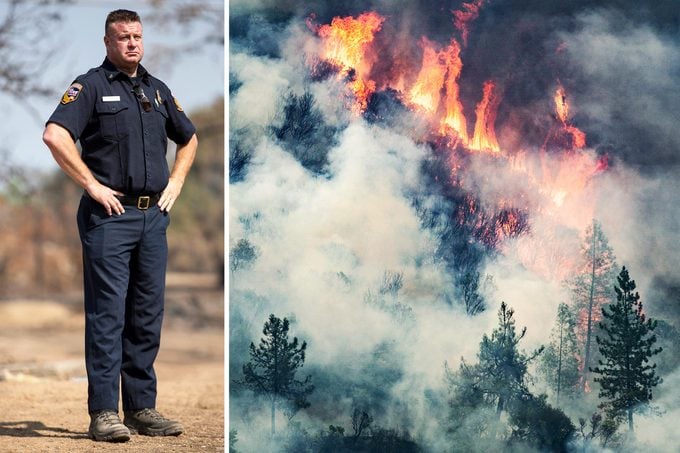
The wildfire had begun in typical fashion—human error colliding with a dry landscape primed to burn. It hadn’t rained in the area since May, and winter precipitation had been 58 percent below normal. More than a dozen other wildfires were already burning across the state, so resources to fight this one were stretched. On July 23, an older couple driving home from a vacation cut through Redding. A tire on their trailer went flat, leaving the wheel to drag on pavement. Sparks flew into parched grass. The fire quickly spread.
Incident Commander Tom Lubas, a 23-year veteran of Cal Fire, and his colleagues set up a command center, called in more firefighters, and carved containment lines. But then the fire exploded from 4,599 acres to nearly 30,000.
Just after noon, Lubas handed off his incident commander role and left base camp at the Shasta County fairgrounds in Redding. Though he had worked in the morning, it was supposed to be his day off, and now he planned to shower and rest. From his truck window, Lubas watched as a 30,000-foot-tall convection column—a plume filled with ash, debris, and hydrocarbons—ballooned into the sky, sucking up the hot air as oxygen fed the fire.
As he drove, his truck registered the temperature outside: 113 degrees. On the coast, 95 miles to the west, it was 59 degrees. As the cool coastal air blew over Bully Choop Mountain and into the Sacramento Valley, the 54-degree difference caused warm air to shoot up in a vortex. As day turned to dusk, the convection column would rotate faster and faster, contorting into a cyclone.
Sometime after 5:30 p.m., as Lubas finished grocery shopping, the sky grew dark. The fire’s behavior alarmed him, so he went back to work, driving to the hills northwest of Redding to assist in evacuating residents. But an hour later, he stopped. He was blocked.
Ahead of him, the tornado twisted. It was sinister and snakelike, a swirl of orange that seemed to fill the entire sky. Flames soared 400 feet in the air. It wouldn’t touch down for another hour, but it was rapidly gaining strength. The tornado would grow to 1,000 feet wide, the size of three football fields, and produce temperatures double those of a typical wildfire. Its howling obliterated every other sound.
Tom Lubas was in shock. Nobody is going to believe this, he thought.
“I’ll lead you out.”
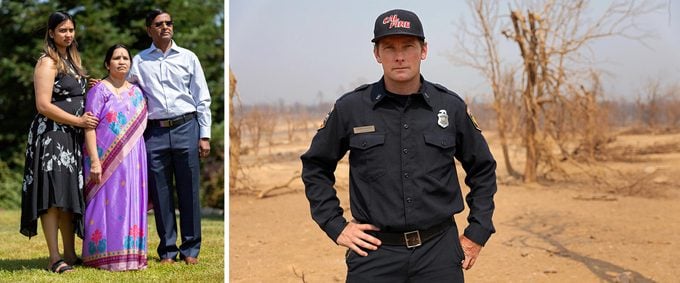
Cal Fire captain Shawn Raley barked evacuation orders over the radio for the neighborhood of Sunset Terrace. The sky was red and the wind screamed, shaking the leaves off trees. New fires lit in shrubs and on roofs. A 24-year veteran of wildland blazes, Raley had seen nearly everything, including swirling eddies of air called fire whirls. But he hadn’t seen anything like this.
At around 7:15 p.m., he drove toward subdivisions tucked into wooded hills. He figured residents would need help escaping. His headlights barely pierced the smoke, but he could see three bulldozers inch past him on two-lane Buenaventura Boulevard. One was driven by Don Andrews, who was unaware of the dangers he was about to face; contractors Terry Cummings and Jimmie Jones drove the other two. They were under electrical lines, which were swaying in the wind, and Raley shouted at the men to move away.
In the driveway of a sprawling house, Raley spotted a Tesla with someone in the driver’s seat. Dr. Nanda Kumar, 62, had raced five miles home from Vibra Hospital of Northern California. His wife, Yasoda Thiruvoipati, 58, and daughter, Dr. Sushma Thiruvoipati, 29, hadn’t received an evacuation alert, and when the power cut out, their garage door wouldn’t open, locking their car inside.
“Go back!” Raley shouted at Dr. Kumar, sounding his siren.
“My wife and daughter are there, can they come in?” Dr. Kumar said, pointing to Raley’s vehicle. He figured they’d be safest with the captain.
“Come in my truck?” Raley asked. “Yes.”
The women jumped into the back seat, coughing. Nearby, flames that climbed 100 feet devoured their neighbors’ homes. Soon theirs would fall as well.
“I’ll lead you out,” Raley yelled to Dr. Kumar. “Take your car.”
Debris pelted the truck, cracking Raley’s windshield and shattering the other windows as the wind blew the vehicle off the road. The captain threw himself across the passenger seat, shielding his face, as the fire passed over them. Yasoda and Sushma screamed.
“Are you OK?” Raley shouted, though he knew the answer. He was embarrassed. He’d told this trapped family he would get them out safely. Now they were covered in glass and bleeding. Behind them, the trunk of Dr. Kumar’s Tesla was aflame.
“I need a water drop!”
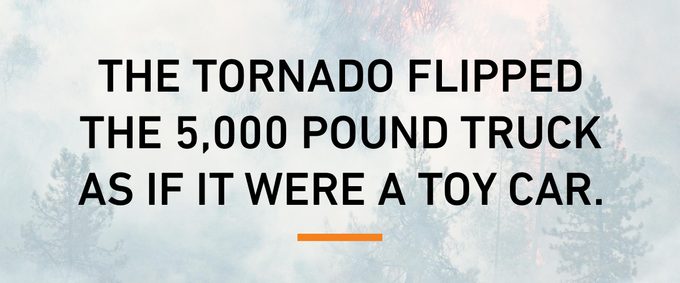
The radio call from Redding fire inspector Jeremy “J.J.” Stoke couldn’t have been more urgent: “Mayday!”
The 37-year-old had cut short a family vacation with his wife and two children to come home and battle the Carr Fire. As the tornado descended, he was driving his truck south on Buenaventura Boulevard. The ferocity of the thing defied his long experience.
“I need a water drop,” Stoke called out at 7:39 p.m., hoping a firefighting plane could bail him out. “I’m getting burned over.”
An engine captain responded immediately, asking for his location. There was no response.
The tornado had picked up Stoke’s 5,000-pound Ford F-150 truck as if it were a toy car, flipping it repeatedly and dragging it down Buenaventura Boulevard. The truck scraped the pavement, leaving a trail of red paint, before coming to rest in the woods.
The twister destroyed everything it touched, buckling an electrical tower into a jumble of steel, lofting a shipping container, and blasting the bark off oak trees.
“Come get us, grandpa.”
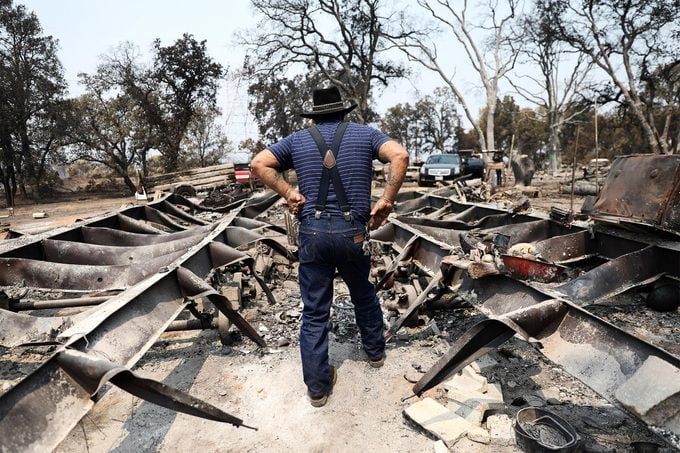
On Quartz Hill Road, 70-year-old Melody Bledsoe soaked blankets in her kitchen sink and draped them over her great-grandchildren, Emily and James “Junior” Roberts, who were four and five years old.
Melody’s husband, Ed Bledsoe, was a handyman who’d gone just down the road to pick up a paycheck. The family hadn’t been ordered to evacuate, and Ed didn’t know the tornado was headed their way until he got a desperate call from Junior while he was stuck in gridlocked traffic.
“Are you coming?” the boy asked, his small voice frantic. The storm was sucking air through the house, rattling the windows, and ripping through the trees outside.
“Don’t worry, Grandpa is coming.”
“You gotta come in the front door; the back door is on fire,” Junior said. “I don’t want you to get hurt.”
“That’s where I’m coming. Be ready. I’ll be there just as quick as I can. I’m waiting for the fire to pass.”
“Tell Grandpa I love him,” Melody said in the background, her voice barely audible.
“Everybody says they love you,” Junior said. “Come get us, Grandpa. There’s starting to be a lot of fire here.”
Then the call went silent.
“Don’t make mistakes.”
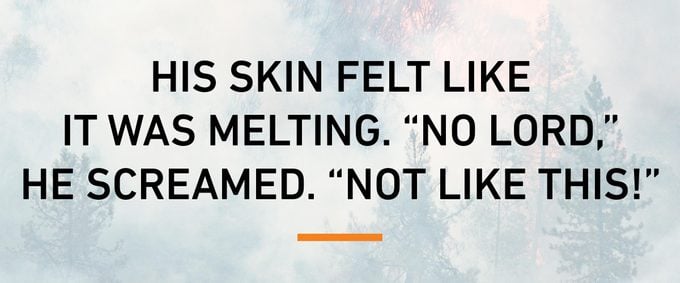 Shortly before 8 p.m., as the blaze spotted around bulldozer driver Terry Cummings in an open field near Buenaventura Boulevard, the 44-year-old attacked the wildfire’s base.
Shortly before 8 p.m., as the blaze spotted around bulldozer driver Terry Cummings in an open field near Buenaventura Boulevard, the 44-year-old attacked the wildfire’s base.
Fire should have scared Cummings. The contractor grew up in the mountains in a logging and milling family. In 2005, his mother, sister, and brother died in a house fire ignited by a candle, and soon after, he shut down the family business. He’d chased wildfires ever since.
Now the field around him was a sea of rippling orange, the embers and flames seemingly alive. He couldn’t breathe from the smoke. He flagged down Andrews and Jones and led their dozers back to Buenaventura Boulevard. He figured they could wait between the steep banks on either side of the road. The air would be clear, and their engines could cool down.
But as they drove north, the tornado descended again, its edges glowing red. It whipped rocks into Cummings’s windshield like bullets, shattering the glass. It was as dark as midnight. Then it picked up the front of his 25-ton bulldozer, pivoted it clockwise, and dropped it on the hood of a nearby truck, which was crushed and aflame. The driver must be dead, Cummings thought.
He reached for the fire shelter tucked behind his seat but nabbed his gear bag by accident. He held it in front of his face to protect his airways. White blisters bubbled on his fingertips. His skin felt like it was melting.
“No, Lord,” he screamed. “Not like this!”
Now, it seemed, he was going to die the way his family had. The tornado sucked Cummings halfway out the shattered window, his body drawn by a gravity he didn’t understand. He gripped the window frame. Jagged glass pierced his left leg as he pulled himself back inside.
Reaching up, he tried to unfold the fire curtains over his dozer’s open windows. But the third-degree burns on his fingers prevented him from undoing the clasps. He grabbed a knife and cut them. Reaching his fire shelter, he pulled its cord as best he could.
“Be calm. Don’t make mistakes,” he repeated to himself.
“The fire is here.”
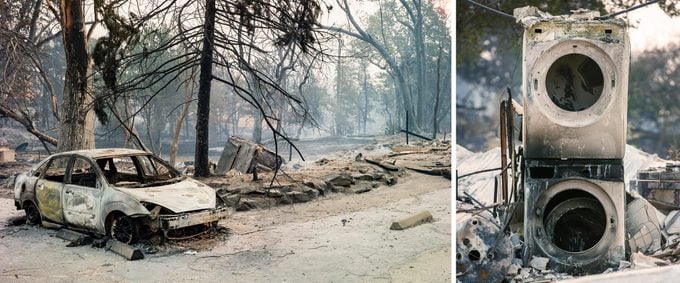
Steve Bustillos sat cringing in the driver’s seat of his truck—the one that sat mangled and flaming under Terry Cummings’s dozer.
A retired San Jose police officer, Bustillos, 55, hadn’t evacuated in time, because he didn’t know he needed to. The fire had moved that quickly. As he drove out of his gated neighborhood just after 8 p.m., he called his wife, who was receiving treatment in the Bay Area for endometrial and lung cancer, both stage IV.
“It might be over,” he told her. “The fire is here.”
Now he was in grave trouble. The fire spreading in his pickup fed off spilled diesel, torching paperwork, jewelry, and guns in the back seat. Bustillos’s hair looked as if someone had taken a blowtorch to it. He knew he couldn’t stay put.
So he climbed outside, grabbing a suitcase filled with clothing, and made a desperate move, crouching in the blade of Cummings’s bulldozer, which provided some protection from the wind. He held the luggage in front of him. Fifteen seconds passed, or possibly 15 minutes. He wasn’t sure.
Embers floated through the air as the wind shifted. Fire danced through the grass and in the trees. Then the temperature dropped, perhaps by as much as 50 degrees. Bustillos saw Cummings sprinting down the street under his semi-deployed fire shelter.
“Get me out of here!” Cummings yelled at a man driving a Cal Fire truck, his voice cracking. “I’m burned really bad.”
Bustillos hopped into a second truck. Then he saw the driver’s face. He knew that expression from decades in law enforcement—the look when someone wearing a uniform, which meant they were supposed to keep people safe, knew that it might not be possible.
“Where’s Don?”
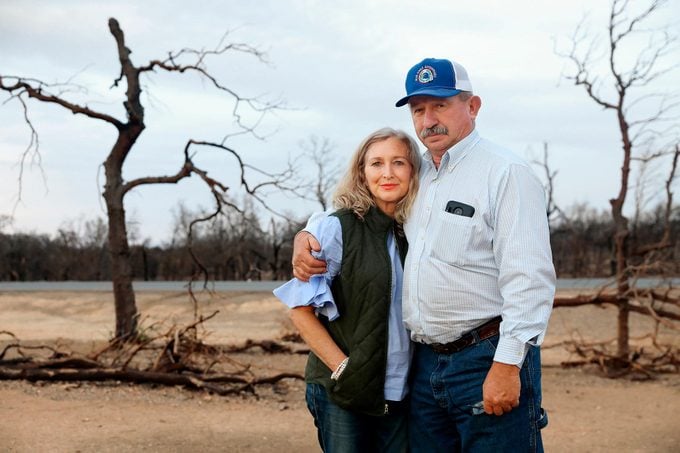
The tornado had blasted across fields, leveled neighborhoods, and rendered the landscape smooth and alien. Two and a half hours after forming, it was finally dissipating.
Down the hill, Commander Tom Lubas watched people stream out of hillside neighborhoods. Their stares were vacant, like those of soldiers returning from battle.
Lubas helped spray down the back of Dr. Kumar’s Tesla, which was still flaming. The family had survived, and Lubas now directed their savior, Captain Raley, to set up a triage area for burn victims. Lubas ordered five ambulances, then left to continue evacuating more residents.
“Where’s Don?” Andrews’s colleague Mike Merdock kept asking. Eventually, Merdock was able to drive up Buenaventura Boulevard and find the bulldozer. He figured Andrews was dead, that he couldn’t possibly have survived. But as he grabbed the back of the contractor’s shirt to haul him out of his vehicle, Andrews twitched.
Together, they drove out of the decimated area. All that was left, for as far as they could see, was ash. In all, the Carr Fire killed eight people, including Jeremy “J.J.” Stoke, Melody Bledsoe, and her great-grandchildren Emily and James “Junior” Roberts, and ruined more than 1,000 homes over 38 days. But as they drove out, all Don Andrews could think was, How did anyone live through this?